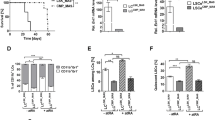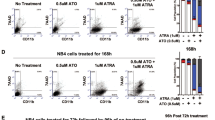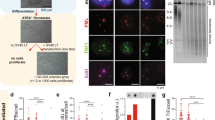Abstract
Human telomerase, a cellular reverse transcriptase specifically activated in most malignant tumors and usually inactive in normal somatic cells, plays an important role in immortalization and tumorigenesis. Early reports have indicated that terminal differentiation of various cells is associated with a rapid inhibition of telomerase activity, preceded by a down-regulation of telomerase reverse transcriptase (hTERT) mRNA. Recently, we have shown that telomerase can be repressed by all-trans retinoic acid (ATRA) independently of terminal maturation during long-term ATRA treatment of the maturation-resistant promyelocytic leukemia cell line (NB4-R1), leading to shortening of telomeres and cell death, events overcome by ectopic hTERT expression. Here, we report the isolation of a variant of NB4-R1 cells (NB4-R1SFD), which bypasses this death step, because of a re-activated telomerase, despite the continuous presence of ATRA. While unresponsive to a long-term maturation independent regulation of telomerase by ATRA, these cells retain a functional pathway of telomerase down-regulation associated with retinoid-induced maturation. These findings reinforce the notion that two distinct pathways of telomerase regulation by retinoids co-exist in APL cells. Noteworthy, we show that the slow developing mechanism, that causes death of maturation-resistant cells, is subjected to a new type of retinoid-resistance as yet not understood.
This is a preview of subscription content, access via your institution
Access options
Subscribe to this journal
Receive 12 print issues and online access
$259.00 per year
only $21.58 per issue
Buy this article
- Purchase on Springer Link
- Instant access to full article PDF
Prices may be subject to local taxes which are calculated during checkout






Similar content being viewed by others
References
Greider CW, Blackburn EH . A telomeric sequence in the RNA of Tetrahymena telomerase required for telomere repeat synthesis Nature 1989 337: 331–337
Nakamura TM, Cech TR . Reversing time: origin of telomerase Cell 1998 92: 587–590
Counter CM, Avilion AA, LeFeuvre CE, Stewart NG, Greider CW, Harley CB, Bachetti S . Telomeres shortening associated with chromosomal instability in immortal cells which express telomerase activity EMBO J 1992 11: 1921–1929
Feng J, Funk WD, Wang SS, Weinrich SL, Avilion AA, Chiu CP, Adams RR, Chang E, Allsoop RC, Yu J, Le S, West MD, Harley CB, Andrews WH, Greider CW, Villeponteau B . The RNA component of human telomerase Science 1995 269: 1236–1241
Harrington L, McPhail T, Mar V, Zhou W, Oulton R Amgen EST Program Bass MB, Isabel A, Robinson MO . A mammalian telomerase-associated protein Science 1997 275: 973–977
Nakamura TM, Morin GB, Chapman KB, Weinrich SL, Andrews WH, Linger J, Harley CB, Cech TR . Telomerase catalytic subunit homologs from fission yeast and human Science 1997 277: 955–959
Beattie TL, Zhou W, Robinson MO, Harrington L . Reconstitution of human telomerase activity in vitro Curr Biol 1998 8: 177–180
Poole JC, Andrews LG, Tollefsbol TO . Activity, function, and gene regulation of the catalytic subunit of telomerase (hTERT) Gene 2001 269: 1–12
Misiti S, Nanni S, Fontemaggi G, Cong Y-S, Wen J, Hirte HW, Piaggio G, Sacchi A, Pontecorvi A, Bachetti S, Farsetti A . Induction of hTERT expression and telomerase activity by estrogens in human ovary epithelium cells Mol Cell Biol 2000 20: 3764–3771
Kyo S, Takakura M, Kanaya T, Zhuo W, Fujimoto K, Nishio Y, Orimo A, Inoue M . Estrogen activates telomerase Cancer Res 1999 59: 5917–5921
Sharma HW, Sokoloski JA, Perez JR, Maltese J-Y, Sartorelli AC, Stein CA, Nichols G, Khaled Z, Telang NT, Narayanan R . Differentiation of immortal cells inhibits telomerase activity Proc Natl Acad Sci USA 1995 92: 12343–12346
Bestilny LJ, Brown CB, Miura Y, Robertson LD, Riabowol KT . Selective inhibition of telomerase activity during terminal differentiation of immortal cell lines Cancer Res 1996 56: 3796–3802
Xu D, Gruber A, Peterson C, Pisa P . Supression of telomerase activity in HL60 cells after treatment with differentiating agents Leukemia 1996 10: 1354–1357
Albanell J, Wan W, Mellado B, Guanawardane R, Sher HI, Dmitrovsky E, Moore MAS . Telomerase activity is repressed during differentiation of maturation-sensitive but not resistant human tumor cell lines Cancer Res 1996 56: 1503–1508
Nason-Burchenal K, Maerz W, Albanell J, Allopenna J, Martin P, Moore MAS, Dmitrovsky E . Common defects of different retinoic acid resistant promyelocytic leukemia cells are persistent telomerase activity and nuclear body disorganization Differentiation 1997 61: 321–331
Yamada O, Takanashi M, Ujihara M, Mizoguchi H . Down-regulation of telomerase activity is an early event of cellular differentiation without apparent telomeric DNA change Leukemia Res 1998 22: 711–717
Xu D, Gruber A, Björkholm M, Peterson C, Pisa P . Suppression of telomerase reverse transcriptase (hTERT) expression in differentiated HL-60 cells: regulatory mechanisms Cancer 1999 80: 1156–1161
Gudas LJ, Sporn MB, Roberts AB . Cellular biology and biochemistry of the retinoids In: Sporn MB, Roberts AB, Goodman DS (eds) The Retinoids: Biology, Chemistry, and Medicine, 2nd edn Raven Press: New York 1994 pp 443–520
Smith MA, Parkinson DR, Cheson BD, Friedman MA . Retinoids in cancer therapy J Clin Oncol 1992 10: 839–864
Chambon P . A decade of molecular biology of retinoic acid receptors FASEB J 1996 10: 940–954
Lippman SM, Lotan R . Advances in the development of retinoids as chemopreventive agents J Nutr 2000 130: 4795–4825
Lippman SM, Parkinson DR, Itri LM, Schantz SP, Ota DM, Schusterman MA, Krakoff IH, Gutterman JU, Hong WK . 13-cis-retinoic acid and interferon alpha-2a: effective combination therapy for advanced squamous cell carcinoma of the skin J Natl Cancer Inst 1992 84: 235–241
Huang ME, Ye YC, Chen SR, Chai JR, Lu JX, Zhao L, Gu RJ, Wang ZY . Use of all-trans retinoic acid in the treatment of acute promyelocytic leukemia Blood 1988 72: 567–572
Castaigne S, Chomienne C, Daniel MT, Ballerini P, Berger R, Fenaux P, Degos L . All-trans retinoic acid as a differentiation therapy for acute promyelocytic leukemia. I. Clinical results Blood 1990 76: 1704–1709
Cornic M, Delva L, Guidez F, Balitrand N, Degos L, Chomienne C . Induction of retinoic acid-binding protein in normal and malignant human myeloid cells by retinoic acid in acute promyelocytic leukemia patients Cancer Res 1992 52: 3329–3334
Shao W, Benedetti L, Lamph W, Nervi C, Miller W Jr . A retinoid-resistant acute promyelocytic leukemia subclone express a dominant negative PML-RARα mutation Blood 1997 89: 4282–4289
Kitamura K, Kiyoi H, Yoshida H, Saito H, Ohno R, Naoe T . Mutant AF-2 domain of PML-RARα in retinoic acid-resistant NB4 cells: differentiation induced by RA is triggered directly through PML-RARα and its down-regulation in acute promyelocytic leukemia Leukemia 1997 11: 1950–1956
Imaizumi M, Suzuki H, Yoshinari M, Sato A, Saito T, Sugawara A, Tshuchiya S, Hatae Y, Fujimoto T, Kakizuka A, Konno T, Linuma K . Mutations in the E-domain of RARα portion of the PML-RARα chimeric gene may confer clinical resistance to all-trans retinoic acid in acute promyelocytic leukemia Blood 1998 92: 374–382
Ding W, Li Y-P, Nobile LM, Grills G, Carrera I, Paietta E, Tallman MS, Wiernick PH, Gallagher E . Leukemic cellular retinoic acid resistance and missense mutations in the PML/RARα fusion gene after relapse of acute promyelocytic leukemia from treatment with all-trans retinoic acid and intensive chemotherapy Blood 1998 92: 1172–1183
Duprez E, Benoit G, Flexor F, Lillehaug JR, Lanotte M . A mutated PML/RARα found in the retinoid maturation resistant NB4 subclone, NB4-R2, blocks RARα and wild-type PML/RARα transcriptional activities Leukemia 2000 14: 255–261
Lanotte M, Martin-Thouvenin V, Najman S, Ballerini P, Valensi F, Berger R . NB4, a maturation inducible cell line with t(15;17) marker isolated from human acute promyelocytic leukemia (M3) Blood 1991 77: 1080–1086
De Thé H, Chomienne C, Lanotte M, Degos L, Dejean A . The t(15 ;17) translocation of acute promyelocytic leukemia fuses the retinoic acid receptor α gene to a novel transcribed locus Nature 1990 347: 558–561
Duprez E, Ruchaud S, Houge G, Martin-Thouvenin V, Valensi F, Kastner Ph, Berger R, Lanotte M . A retinoid acid ‘resistant’ t(15 ;17) acute promyelocytic leukemia cell line: isolation, morphological, immunological and molecular features Leukemia 1992 6: 1281–1287
Ruchaud S, Duprez E, Gendron MC, Houge G, Genieser HG, Jastorff B, Doskeland SO, Lanotte M . Two distinctly regulated events, priming and triggering, during retinoid-induced maturation and resistance of NB4 promyelocytic leukemia cell line Proc Natl Acad Sci USA 1994 91: 8428–8432
Pendino F, Flexor M, Delhommeau F, Buet D, Lanotte M, Ségal-Bendirdjian E . Retinoids down-regulate telomerase and telomere length in a pathway distinct from leukemia cell differentiation Proc Natl Acad Sci USA 2001 98: 6662–6667
Kim N, Piatyszek MA, Prowse K, Harley C, West M, Ho P, Coviello G, Wright W, Weinrich S, Shay J . Specific association of human telomerase activity with immortal cells and cancer Science 1994 266: 2011–2015
Bryan TM, Englezou A, Gupta J, Bachetti S, Reddel RR . Telomere elongation in immortal human cells without detectable telomerase activity EMBO J 1995 14: 4240–4248
Bryan TM, Englezou A, Dalla-Pozza L, Dunham MA, Reddel RR . Evidence for an alternative mechanism for maintaining telomere length in human tumors and tumor-derived cell lines Nat Med 1997 3: 1271–1274
Ulaner GA, Hu JF, Vu TH, Giudice LC, Hoffman AR . Telomerase activity in human development is regulated by human telomerase reverse transcriptase (hTERT) transcription and by alternate splicing of hTERT transcripts Cancer Res 1998 58: 4168–4172
Zhang A, Zheng C, Lindvall C, Hou M, Ekedahl J, Lewensohn R, Yan Z, Yang X, Henriksson M, Blennow E, Nordenskjold M, Zetterberg A, Bjorkholm M, Gruber A, Xu D . Frequent amplification of the telomerase reverse transcriptase gene in human tumors Cancer Res 2000 60: 6230–6235
Duprez E, Lillehaug JR, Gaub MP, Lanotte M . Differential changes of receptor (RXRα) and its RARα and PML-RARα partners induced by cAMP and retinoic acid distinguish maturation sensitive and resistant t(15;17) promyelocytic leukemia NB4 cells Oncogene 1996 12: 2443–2450
Acknowledgements
This work was supported by the Institut National de la Santé et de la Recherche Médicale, the Ligue Nationale contre le Cancer and the Association pour la Recherche contre le Cancer (ARC Nos 5384, and 5707). TS and FP were supported by the Coopération Franco-Algérienne, and the Ministère de la Recherche et de la Technologie, respectively. We thank Dr G Chabot (INSERM U496) for critical reading of the manuscript.
Author information
Authors and Affiliations
Rights and permissions
About this article
Cite this article
Pendino, F., Sahraoui, T., Lanotte, M. et al. A novel mechanism of retinoic acid resistance in acute promyelocytic leukemia cells through a defective pathway in telomerase regulation. Leukemia 16, 826–832 (2002). https://doi.org/10.1038/sj.leu.2402470
Published:
Issue Date:
DOI: https://doi.org/10.1038/sj.leu.2402470
Keywords
This article is cited by
-
Involvement of epigenetic modification of TERT promoter in response to all-trans retinoic acid in ovarian cancer cell lines
Journal of Ovarian Research (2019)
-
Telomerase regulation by the long non-coding RNA H19 in human acute promyelocytic leukemia cells
Molecular Cancer (2018)
-
Anti-microbial and cytotoxic 1,6-dihydroxyphenazine-5,10-dioxide (iodinin) produced by Streptosporangium sp. DSM 45942 isolated from the fjord sediment
Applied Microbiology and Biotechnology (2014)
-
Epigenetic plasticity of hTERT gene promoter determines retinoid capacity to repress telomerase in maturation-resistant acute promyelocytic leukemia cells
Leukemia (2010)
-
Telomerase targeting by retinoids in cells from patients with myeloid leukemias of various subtypes, not only APL
Leukemia (2006)



